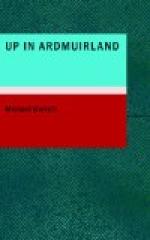During the term (as we may call it) the procedure was as follows: Farquharson was accustomed to rise about four o’clock and to work for two or three hours at threshing corn. After an early breakfast he made preparations for his scholastic duties by clearing out of the way all unnecessary furniture—though there was little that was superfluous—and placing the long planks supported by big stones which served for forms. As some children were sure to be occupied with class work during the whole time, fewer seats were needed than would have been necessary otherwise. The schoolmaster’s old mother, Margot, kept her own chair by the fire, where she kept an eye on the pot of soup and occupied herself with knitting. The one small table served as master’s desk and as writing-table for those pupils who had advanced sufficiently in the art to be allowed to use a copy-book instead of a slate—but they were few.
The scholars arrived about eight o’clock. It was required of each, as part of the school fees, to bring a block of dried peat to serve as fuel for the fire. It was always the ambition of a boy of lively temperament, such as Willy represented himself to be, to choose as hard a “peat” as he could possibly find, to serve as a weapon in the mimic battles fought on the road to school. As the fire was composed wholly of peat, and the chimney was wide, the place would be often a difficult one to study in when the wind was in the wrong quarter. At such times, to use Willy’s description:
“It wes juist a reeky hole! We wes all well learned to pit up wi’ the reek! I niver thocht muckle o’ reek aifter that schule!”
The proceedings began with reading; after that came spelling. “Coontin’” followed for those who were sufficiently accomplished.
“Them as wes best at the readin’ spent nearly all day at the coontin’ and writin’. The maister wes short enuch in the temper,” remarked Willy on this point. “Aye, aye, he wes gey hot in the temper, I insure ye! I mind a loon comin’ up to him ane day wi’ a coont on his slate, ye ken, an’ Farquharson wes that enraged at a mistak’ i’ the coont that he broke the slate on the laddie’s heid an’ left the frame hangin’ like a horse’s collar roond his neck!”
Farquharson evidently held to the great principle that corporal punishment was part of a sound education. Behind the door was a stool, which served as a block upon which to stretch a victim whose offense deserved the extreme punishment, but that was not often required. A favorite instrument was the strap, or, as Willy termed it, “the belt.” Should the master catch sight of an idler, or practical joker, he would throw the strap to the delinquent as a sign that a thrashing was due, and the boy or girl had to come up to his table and receive the punishment.
“Some wad be stiff to come up wi’t, ye ken,” explained Willy; “but he’d niver let a loon off, though he wes mair merciful-like to the wee lassies. He’d larnt by experience, ye ken; for in the auld days, afore I went there, ane o’ the lassies wes a month awa’ frae the schule—he throosh her that severe.”




